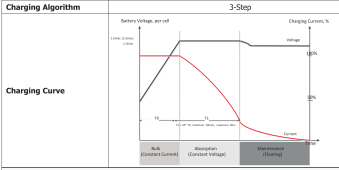triplethreat
Solar Enthusiast
- Joined
- Oct 12, 2021
- Messages
- 129
Chris, after reading about the 2 stage charging, I agree, it would just shut off when when the current drops off to 10% and I would have no power to the camper other than what is provided by the battery.......zero converter type function.This is my take on what the manual says as well, how I would try it first - 3 stage with float. Confirmation from Mean Well is that this charger does not re-boost without disconnecting it from shorepower. At first I was looking for a re-boost voltage level, then realize you either plug into shorepower or genset, either way it charges your battery fully then goes into float to maintain loads for the duration. And yes, it will supply loads up to the rated current output to maintain the float voltage.
Initially I thought the 2-stage was the answer, but I suspect if there's no float there's no load supply either, charging terminates at 10% of rated current, and doesn't reset until power is reset. But 3-stage for FLA at 14.2 and 13.4 seems perfect. The 'gel' setting might be good as well. As mentioned, it kind of depends on how the unit reads the battery voltage, and how much voltage sag you have in your wiring. I don't really get any sag - my 4awg leads are a foot long.
Voltage adjustment is an easy dip-switch affair, or if you really want to fine tune everything you need their BT interface and app, I think it's about $65. I captured the standard dip-switch settings from the data sheet below.
I'm anxious to hear how it works for Time2Roll.
For the WFCO unit, the only problem with the CV 13.6V is the differential is so low that current gets cut way back - it can take a long time to get there, and that is the chief complaint with them - they never boost. But yes, it's worth a shot - try it and see if it works for you. It's like just constant float.

One of the things I'm failing to see (might be that thick-headed thing again), is when 3 stage charging is shown, the chart shows boost voltage at xx.x volts (depending on settings) and then the next column is float voltage. Under normal chargers, there is an absorption voltage, then float voltage. So I guess with the Meanwell, the "absorption" is when it goes out of boost and it is tapering the current down until it reaches the 10% current flow target, and then it switches to float voltage. Is that the way you see it also?






